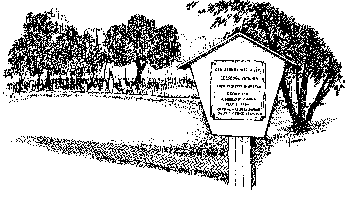The first records of American Methodism date from the 1760s. In New York and Pennsylvania, Philip Embury, Barbara Heck, and Thomas Webb were leaders in the movement. Further south, Robert Strawbridge brought Methodism to the Delmarva peninsula.
It is likely that the Methodist society in Leesburg was formed under Strawbridge’s influence. It was undoubtedly the first in Virginia, although its founding date is not known. What is certain is that on May 11, 1766, Nicholas Minor of Leesburg deeded Lot 50 to Methodist layman Robert Hamilton for “no other use but for a church or meeting house and grave yard.” This lot is the earliest known American Methodist church property.
The first meeting house, made of stone, was built by 1768. It was replaced by a larger building between 1785 and 1790. A number of prominent early Methodists preached in the church, including Thomas Rankin, Wesley’s missionary to America; Francis Asbury (who preached there in 1776); and William Watters, the first American-born Methodist traveling preacher.
The church parsonage was originally a private home, built in 1762. In 1816, the congregation purchased the home for a token $1.00 from the owners, who were church members, for use as the pastor’s residence.
In 1844, the Methodist Episcopal Church split into northern and southern bodies. The Old Stone Church, then part of the Baltimore Annual Conference, remained with the northern church, but in 1848 a number of Southern sympathizers withdrew to form their own congregation in Leesburg.
By the late nineteenth century, the congregation of the Old Stone Church was in decline. For some years, black and white groups alternated use of the building. Finally, the church was abandoned in 1894.
In 1900 the property was sold and the building was torn down. Black members had formed Mt. Zion Church in Leesburg in 1867 and white members joined the Southern Methodist Church that had been formed in 1848.
The Methodist Historical Society of the Virginia Annual Conference purchased the site in 1961. A few years later, archaeological study began under the Society’s auspices, and the foundations of both churches (1768 and 1785-90) were identified.
Points of interest at this Heritage Landmark: Visitors can see the site and foundation stones of the Old Stone Church. There is an interpretation center on the grounds with extensive interpretive labels.
At the site is the cemetery with graves dating to the 1770s (including that of Richard Owings, first American-born local preacher; and Captain Wright Brickell, one of the original book stewards of the Methodist Episcopal Church).
The former parsonage is now a private home next to the site.
Some artifacts from the Church are on display in the present Leesburg United Methodist Church (one block from the site).
To support the preservation and interpretation of this Heritage Landmark, contact the Old Stone Church Foundation, P.O. Box 426, Leesburg, VA 22075.
Special events: An annual dinner meeting of the Old Stone Church Foundation is held at the Leesburg United Methodist Church in September.
Area attractions: Washington, DC, with its many historical and cultural attractions is a short drive to the southeast. Leesburg is also near several Civil War historic sites, including the Manassas Battlefield and Harpers Ferry.
To visit: The site, interpretation center, and cemetery may be viewed during daylight hours.
To visit the parsonage, contact the owner, St. James Episcopal Church, 703-777-1124. This is a private residence, and access is extremely limited.
To visit the Leesburg United Methodist Church, contact the church, 107 West Market St., 703-777-2056, and speak with the church secretary.
Location: Within the boundaries of the Virginia Annual Conference in Loudoun County, Virginia. Leesburg is northwest of Washington, DC on the Potomac River.
Food and lodging: There are several motels and restaurants in Leesburg.
Directions: From Interstate 66, take Rt. 15-BUS twenty-six miles north to the center of Leesburg. Turn left on Cornwall Street; the former parsonage is one block up at 102 Cornwall St. N.W. The church site and cemetery are next door, 110 Cornwall Street, N.W.
The site may also be accessed from Interstate 70 by taking U.S. 15 south from Frederick, Maryland, twenty-two miles into Leesburg on Rt. 15-BUS, and turning right onto Cornwall Street.
For further information, contact: Old Stone Church Foundation, P.O. Box 426, Leesburg, VA 22075; 804-355-0100.
To learn more about United Methodist church history in this area:
Virginia Annual Conference Archives, P.O. Box 1719, Glen Allen, VA 23060, 804-521-1132, Stephanie Davis, Archivist.
Matthew H. Moore, Sketches of the Pioneers of Methodism in North Carolina and Virginia (Greenwood, SC: Attic Press, 1977; originally published in 1884).
William Warren Sweet, Virginia Methodism; A History (Richmond: Whittet & Shepperson, 1955).

